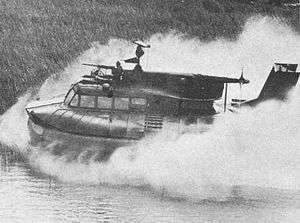SR.N5
 US Navy PACV (SK-5) in Vietnam | |
| Class overview | |
|---|---|
| Name: | SR.N5 Warden class |
| Builders: | British Hovercraft Corporation |
| Preceded by: | SR.N4 |
| General characteristics | |
| Type: | Hovercraft |
| Displacement: | 17,500 lb (7.9 t) maximum |
| Length: | 39 ft 5 in (12.01 m) |
| Beam: | 22 ft 9 in (6.93 m) |
| Height: | 16 ft 9 in (skirt inflated) |
| Propulsion: | 1 × 900 shp (671 kW) Rolls-Royce Gnome turbine engine for lift and propulsion |
| Speed: | 70 knots (130 km/h; 81 mph)[1] |
| Range: | 240 nm (3 hr 30 min) at 15,800 lb weight |
| Capacity: | 6,600 lb load including crew and fuel |
| Troops: | 16 |
| Notes: | from Flight[2] |
The Saunders-Roe SR.N5 (or Warden class) was a medium-sized hovercraft which first flew in 1964. It has the distinction of being the first production-built hovercraft in the world.
A total of 14 SR.N5s were constructed. While Sauders-Roe had developed and produced the type, an additional seven vehicles were also manufactured by Bell Aerosystems under licence in the United States, designated as the Bell SK-5. A number of SK-5s were operated by the US military, this includes a number which became Patrol Air Cushion Vehicles (PACV), and saw action in Vietnam. The SR.N5 was subsequently developed into "stretched" variant, which was designated as the SR.N6 and went on to be produced in greater numbers
Design and development
The first SR.N5 (001) started sea trials in April 1964; as a result fin area was increased and a system for ducting plenum air to improve low speed handling.
Operational history
Civilian service
At least two of the Bell-built SK-5s were placed into civilian service.[3] San Francisco and Oakland Helicopter Airlines operated the SK-5 for scheduled passenger services in the San Francisco Bay Area during the mid 1960s as a supplement to its helicopter airline service.
Military service
Four SR.N5s entered service with the Interservice Hovercraft Trials Unit at RNAS Lee-on-Solent (HMS Daedalus) for trials and operational missions. Given the military aircraft serial numbers XT492, XT493, XT657 and XW246, these were deployed in the UK, Malaysia, Thailand, Aden, Libya and Belgium. Two were subsequently converted to SR.N6s.
Vessel XT 492 is prominently featured in the final of the 1971 Dr Who Serial The Sea Devils.
Three Bell SK-5s saw service with the United States Navy and another three with the United States Army in Vietnam during the late 1960s.
The Sultanate of Brunei and the Canadian Coast Guard had one SR.N5 each.
References
Citations
- ↑ with 6 inch clearance under skirt
- ↑ Flight 23 July 1965, p. 10.
- ↑ "Air-Cushion Vehicle International Supplement." Flight International, 30 December 1965. p. 77.
Bibliography
- "Westland SR.N5." Flight International Supplement, 23 July 1964. pp. 5-11.
- Hovercraft Museum: SR.N5
- Hovercraft Museum: Craft Built